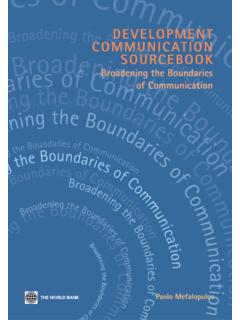Transcription of 12. Governance and Management - World Bank
1 12. Governance and Management Principles and Norms DEFINITIONS. Governance concerns the structures, functions, processes, and Elaborates on organizational traditions that have been put in place within the con- IEG's Phase 2. text of a program's authorizing environment to ensure that the [pro- report of the gram] is run in such a way that it achieves its objectives in an effective World Bank's and transparent manner. 63 It is the framework of accountability to involvement in users, stakeholders and the wider community, within which organiza- global programs tions take decisions, and lead and control their functions, to achieve their objectives.
2 64 Good Governance adds value by improving the performance of the program through more efficient Management , more strategic and equitable resource allocation and service provi- sion, and other such efficiency improvements that lend themselves to improved development outcomes and impacts. It also ensures the ethical and effective implementation of its core functions. Management concerns the day-to-day operation of the pro- gram within the context of the strategies, policies, processes, and pro- cedures that have been established by the governing body. Whereas Governance is concerned with doing the right thing, Management is concerned with doing things right.
3 65. The boundary between Governance and Management is not hard and fast. In particular, both the maturity and the size of the pro- gram will influence the dividing line and the degree of separation be- tween the program's Governance and Management structures. Less- mature programs may take time to establish formal Governance mechanisms. Smaller programs with limited staffing and financial re- sources may tend to blend responsibilities between those who govern and those who manage, and to call on governing body members to be more involved in specific day-to-day Management decisions. The ex- tent of Governance should be proportionate to the size of the program in order not to result in an over-governed and under-performing pro- gram.
4 63. Institute of Chartered Secretaries and Administrators International, no date, Principles of Corporate Governance for Charities, p. 2. 64. United Kingdom Audit Commission, October 2003, Corporate Governance : Improvement and Trust in Local Public Services, p. 4. 65. This distinction is attributed to Robert Tricker: The role of Management is to run the enterprise and that of the board is to see that it is being run well and in the right direction. Robert I. Tricker, 1998, Pocket Director, p. 8. 71. FUNCTIONS OF Governance . Elaborates on The governing bodies of GRPPs typically exercise six core and applies functions:66.
5 OECD Principles of Corporate Strategic direction. Exercising effective leadership that opti- Governance to mizes the use of the financial, human, social, and technological GRPPs resources of the program. Establishing a vision or a mission for the program, reviewing and approving strategic docu- ments, and establishing operational policies and guidelines. Continually monitoring the effectiveness of the program's Governance arrangements and making changes as needed. Management oversight. Monitoring managerial performance and program implementation, appointing key personnel, ap- proving annual budgets and business plans, and overseeing major capital expenditures.
6 Promoting high performance and efficient processes by establishing an appropriate balance be- tween control by the governing body and entrepreneurship by the Management unit. Monitoring compliance with all appli- cable laws and regulations, and with the regulations and pro- cedures of the host organization, as the case may Stakeholder participation. Establishing policies for inclusion of stakeholders in programmatic activities. Ensuring adequate consultation, communication, transparency, and disclosure in relation to program stakeholders that are not represented on the governing bodies of the program. Risk Management .
7 Establishing a policy for managing risks and monitoring the implementation of the policy. Ensuring 66. These core functions, and the criteria for assessing the performance of governing bodies in the standards section below, are adapted from the OECD Principles of Corporate Governance (2004). Although there exist other similar statements of such principles at the national level, the OECD Princi- ples are the only set of corporate Governance principles on which there is clear international consensus. Many Governance functions for the for-profit private sector, as laid out in the OECD Principles, translate directly into equivalent functions for GRPPs (as well as for other public sector organiza- tions, NGOs, and foundations).
8 The key differences for GRPPs are the ab- sence of tradable shares, the need to establish legitimacy on a basis other than shareholder rights, and the greater need for transparency in the use of public sector resources in achieving public policy goals. 67. In this Sourcebook, the terms oversight and supervision are used for two distinctly different activities. Oversight refers to the monitoring of the program Management unit by the governing body, while supervision refers to the monitoring of individual program activities by the staff (or in some cases contractors) of the program Management unit. 72. that the volume of financial resources is commensurate with the program's needs and that the sources of finance are ade- quately diversified to mitigate financial shocks.
9 Conflict Management . Monitoring and managing the poten- tial conflicts of interest of members of the governing body and staff of the Management unit. Monitoring and managing con- flicting interests among program partners and participants, especially those that arise during the process of program im- Audit and evaluation. Ensuring the integrity of the program's accounting and financial reporting systems, including inde- pendent audits. Setting evaluation policy, commissioning evaluations in a timely way, and overseeing Management up- take and implementation of accepted recommendations. En- suring that evaluations lead to learning and programmatic en- hancement.
10 In the case of programs that are housed in other organizations, the host organization may be responsible for performing some of these functions in collaboration or consultation with the governing body. FUNCTIONS OF Management . Management functions vary by program size and type, part- nership arrangement, legal arrangement, etc. While the proceeding list is not exhaustive, seven general functions of GRPP Management are as follows: Program implementation. Managing financial and human re- sources. Reviewing proposals for inclusion in the portfolio of activities and allocating financial resources among activities. Supervising the implementation of activities.
















